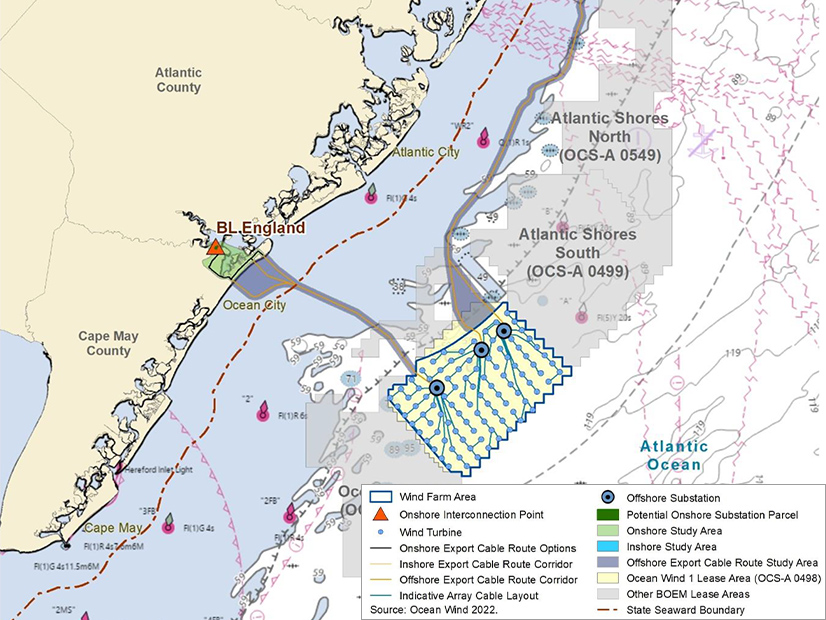
The U.S. Bureau of Ocean Energy Management (BOEM) issued a final environmental impact statement (EIS) Monday for Ocean Wind 1, New Jersey’s first offshore wind project, concluding that the project combined with others will have a “major” impact on scenic and visual factors and on scientific research, but only a “moderate” impact on a host of other issues.
The over 2,300-page report, which will be used as a touchstone by federal and other decision-makers to determine the future of Ørsted’s 1,100-MW Ocean Wind 1 project, said the impact of the project alone on scenic and visual factors such as the “seascape, open ocean, and landscape character and viewers” would be only “moderate.”
But the cumulative impact of the project, which would erect 98 turbines about 15 miles from Atlantic City, on scenic and visual factors would be “major” once combined with “other ongoing and planned activities” in the area, the EIS said.
There could be 859 turbines installed in the area between 2024 and 2030 if all other planned projects go ahead, the report said. The EIS found the cumulative scenic and visual impact would be “major” even if Ocean Wind 1 did not go ahead.
Because Ocean Wind 1 is the state’s first offshore wind project, the EIS provides a kind of guideline for other, future projects. The BOEM release announcing the EIS said it will issue a decision on the project in the summer.
The EIS evaluates the impact of the project on 18 factors and defines the impact as either major, moderate, minor or negligible. The study also looked at four other scenarios with changes made to mitigate the impact, such as creating a buffer between it and an adjacent project or placing its turbines closer together.
Maddy Urbish, head of government affairs and market strategy in New Jersey for Ørsted, welcomed the release of the EIS.
“Ocean Wind 1 continues to advance through the multiyear federal permitting process, and we’re pleased to reach this latest milestone,” she said. “Ocean Wind 1 anticipates onshore construction beginning in the fall and offshore construction activities ramping up in 2024.”
OSW Progress
The release comes a week after BOEM issued the draft EIS for the 1,510-MW Atlantic Shores project, one of two projects approved by the New Jersey Board of Public Utilities in its second OSW solicitation. The other project, the 1,148-MW Ocean Wind 2, was also developed by Ørsted. (See BOEM Draft EIS Finds Potential Major Impacts from 1st NJ OSW Project.)
BOEM said the release of the EIS for Ocean Wind 1 is part of the agency’s ongoing effort to meet President Joe Biden’s goal of deploying 30 GW of OSW energy capacity by 2030. The agency said it held three public hearings and received 1,389 comment submissions.
“BOEM continues to make progress towards a once-in-a-generation opportunity to build a new clean energy industry in the United States,” BOEM Director Elizabeth Klein said.
The progress in New Jersey is far from assured, however. Offshore wind projects face opposition from the commercial fishing sector, Jersey Shore homeowners, the tourism sector and state business groups concerned at the cost. Two local governments that represent communities through which Ørsted plans to run cables from the offshore generators to the state grid — Cape May County and Ocean City — have sued in state court to overturn the BPU’s approval of easements to allow the cable installation. (See County Contests Tx Easement for NJ’s 1st OSW Project.)
BOEM found Ocean Wind 1 would have only moderate impact in most of the categories studied, among them: recreation and tourism; navigation and vessel traffic; coastal habitats; birds; and water and air quality. It found a negligible to minor impact on land use and coastal infrastructure.
The study found the impact of the Ocean Wind 1 alone on scientific research and surveys would be major, as would the cumulative impact of the project and others nearby, including on National Oceanic and Atmospheric Administration surveys that support commercial fisheries and protected species research programs.
“The entities conducting scientific research and surveys would have to make significant investments to change methodologies to account for areas occupied by offshore energy components, such as [wind turbine generators] and cable routes, that are no longer able to be sampled,” the study said.
Significant Impact on Commercial Fishing, Whales
Similarly, the study found the impact on the commercial and for-hire recreational fishing sectors would be major, both from the project itself and the cumulative impact. In both cases, the impact would be “minor to major on commercial fisheries and minor to moderate on for-hire recreational fishing depending on the fishery or fishing operation.”
Even if Ocean Wind 1 did not go ahead, the commercial fishing sectors would face challenges from busy port use, inflated vessel activity, other offshore development and climate change issues, the EIS says.
If the project goes ahead as planned or with modifications, the factors that would determine the scale of the impact include: number, size and location/orientation of turbines; length and route of inter-array and offshore export cables; number of simultaneous vessels, number of trips and size of vessels, which could affect potential risk for vessel collisions and use of port facilities; and time of year during which construction occurs, which could affect access to fishing areas and availability of targeted fish in the area, thereby reducing catch and fishing revenue.
The study found that the impact on mammals would in general be moderate. But it found the impact of the project alone, and the cumulative impact with other projects, would be moderate to major for North Atlantic right whales.
The impact on the right whale population has emerged as a significant issue in New Jersey after a spate of whale deaths in recent months, with the bodies washing up on the Jersey Shore. Opponents of OSW, and two Republican members of Congress, have suggested the deaths could be linked to preliminary marine studies being conducted for the OSW projects. However, federal and state officials say there is no evidence linking the deaths with the wind projects.
The EIS says right whales are already facing considerable stress factors, including elevated vessel activity and collisions, and the effects of climate change. Because “offshore wind construction, operation and maintenance activities would be conducted with applicant-proposed and agency-required mitigation measures,” the activities are “not anticipated to substantially contribute to the major impacts,” the EIS states.
However, the study added that that “it is unknown whether the population can sufficiently recover from the loss of an individual to maintain the viability of the species.”
